On May 3rd, 1978, construction workers in San Francisco were digging a foundation for a new building on Sansome Street, right next to the Transamerica Pyramid in the heart of the financial district. About 20 feet below street-level their shovels hit something totally unexpected. It was the hull of an old boat.
Within a few days archaeologists had uncovered the full skeleton of a 120-foot gold rush era ship called the Niantic. Inside the ship were all kinds of objects that the 49ers needed before they headed off to the gold fields, including bricks, nails, tin plates, boots, jackets, saddles, shovels … and lots of booze.
The Niantic is not the only ship buried under the streets of San Francisco. Some estimates put the number as high as seventy. Most arrived in 1848 and 49 as part of the Gold Rush. By the end of 1850, the waterfront was clogged with more than a thousand ships, and the town had grown from a village to the twelfth largest city in North America.
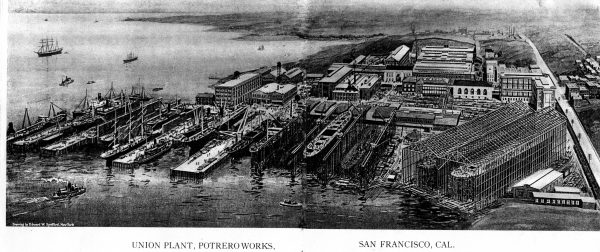
The land around San Francisco (mostly sandy hills) was not well suited to this scale of development, so to meet the surging demand for real estate, the city sold off plots of water in the shallow tidal zone. People drove stakes in the ground and built platforms on top of the water. Others repurposed the ships that had brought them to California. They became floating houses, warehouses, the town jail, saloons and more.
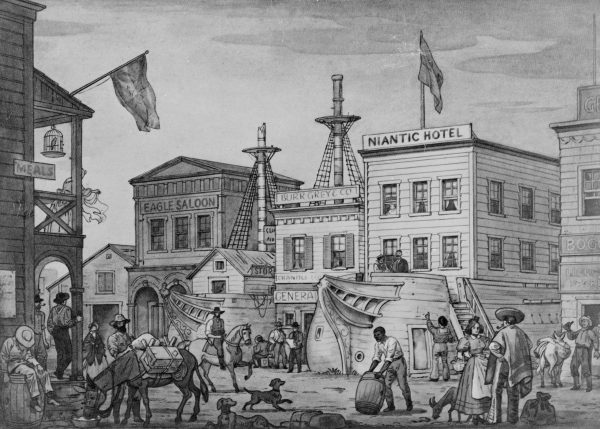
Some people began dumping sand or garbage in their plots to make land and as more and more plots were filled in, the shoreline began to advance. Then on May 4th, 1851, a massive fire broke out. Ships caught fire and sank. By the time the fire was put out, the waterfront was a mess of smoldering timber that was too unstable to rebuild on. So construction workers used steam-powered excavators to scrape sand off of nearby hills and dump it on top.
The Niantic and all the other gold rush ships were entombed in this manufactured ground. Today this former tidal zone is now the heart of the financial district. And this is just one example of a widespread phenomenon. Throughout history, the absence of ground has proved to be a surprisingly small obstacle for people who want to build.
San Francisco isn’t the only city that has created new land. Large portions of New York City, Boston, Seattle, Hong Kong and Marseilles were built on top of fill. What is now Mumbai, India, was transformed by the British from a seven-island archipelago to one contiguous strip of land. The most extraordinary example of land reclamation and manufacture may be the Netherlands. As early as the 9th century A.D., the Dutch began building dykes and pumping systems to create new land in places that were actually below sea level.
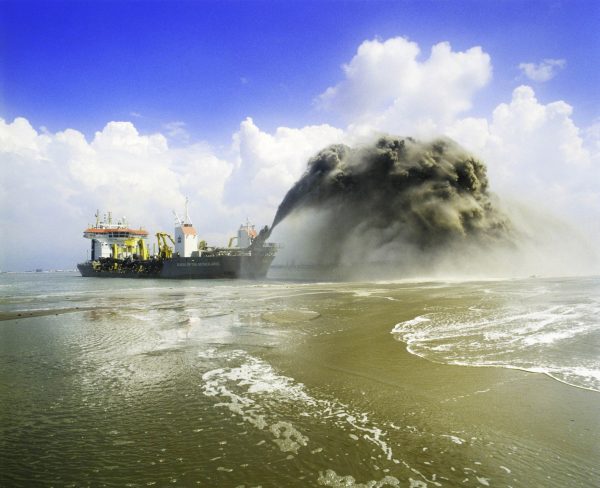
The historic scale of land manufacture is minuscule compared to the rate at which it is taking place today. More and more cities are building expensive waterfront property for airports, skyscrapers and housing. And new dredging technologies have enabled developers to build land faster and on a grander scale, often at the expense of the environment.
Dubai has created a series of artificial islands for wealthy elites designed to look cool from Google Earth. But the wealthy desert Emirate is actually running out of sand (desert sand is too fine for construction) so they have to import it from elsewhere. So much sand is being used for concrete production and land manufacturing projects that there is now a global sand shortage. And that has forced countries to go to extreme lengths in their efforts to build new land.
Singapore, one of the wealthiest, densest countries in the world, has essentially stolen sand from poorer countries like Cambodia, Indonesia, and Burma in order to expand its footprint.
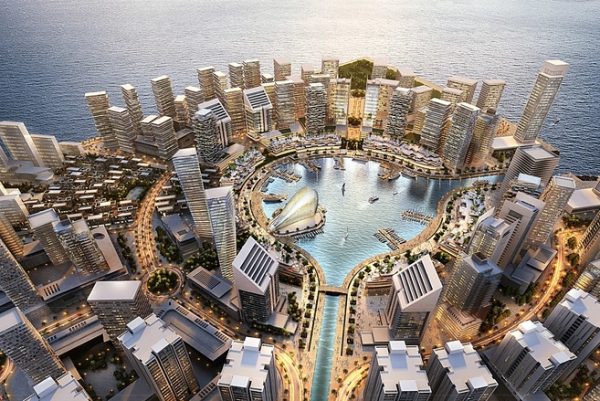
Land manufacturing projects are also designed to lift a country higher above the sea. A new luxury community called Eko Atlantic near the coastal city of Lagos, Nigeria will be 3-4 meters higher than the rest of Lagos in order to make Eko Atlantic more resistant to sea level rise.
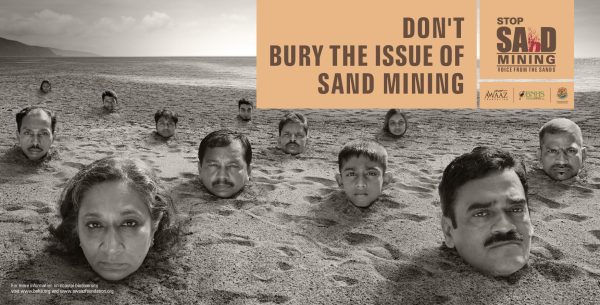
This is creating a disturbing geography where elites can build new land to escape the effects climate change, while one of the poorest cities in the world goes unprotected.
Reclamation projects like Eko Atlantic are the most obvious examples of manufactured land, but even if you live far from the coast, the ground beneath your feet may be partially created by humans.
Human activity has effectively created a new layer on the surface of the planet, made up of old bricks, cement and rusting metal. Geologists and archaeologists have started calling this layer the archaeosphere.
The archaeosphere covers most of the humanly populated areas on earth. Generally: the older the area, the bigger it is in that area. In the center of London, it reaches ten meters below the surface.
Today, this layer is growing faster than ever before as we move huge amounts of material from one place to another. And we need to understand what the ground is made of if we want to build safely on top of it. Manufactured ground can be unstable and more susceptible to earthquakes and landslides.
But the archaeosphere is also a resource to be explored. In Scandinavia, for example, they are mining the industrial ground of their own cities for copper and other resources.
Understanding what’s in the ground is also about understanding history. We tend to see the ground beneath our feet as something that has always been there, an immutable part of our planet. But in reality cities make their own geology by building their own ground.



Comments (6)
Share
fantastic episode! best one in a long time (and that’s saying something). more urban history episodes please!
You are right, one of the best from recently episodes. More episodes like this would be awesome!
Spellbinding.
“This is 99% Invisible. I’m Roman Mars” captivated me from the first time I heard Nikko on a 1,500 mile road trip. Excellent episode. Thank you.
Fantastic episode, BUT! You missed a golden opportunity to mention ancient cultures that did this sort of thing, like the earthen mounds of the American southeast or the Tels of the Middle East and the Levant. What’s old is new again, right? :-)
I loved this episode, not least because I live in Tampa, where we also built an island out of sediment. It was previously called Seddon Island after E.L. Seddon, who actually created it by dredging a channel to make port access easier and dumping the remaining dirt on and around what was originally “Grassy Island”, but renamed Harbour Island in the early 1985 when a group of developers tried to duplicate the success of Baltimore’s Harborplace, which had opened in 1980, and still remains vibrant today.
I have relatives in Baltimore, though, and as such have visited both in their respective heydays. Harbour Island never took off the way Harborplace did.
The change in the Boston harbor can be seen in Yunjie Li’s fantastic historic map.
https://www.mapbox.com/blog/historic-boston-in-dataset-editor/?utm_source=sept-designer&utm_medium=email&utm_content=boston-blog&utm_campaign=sept-designer